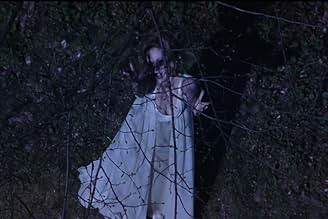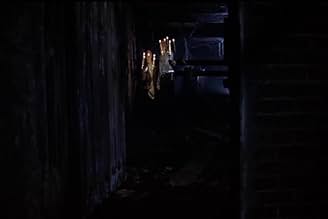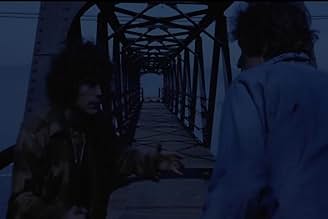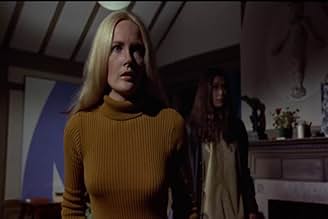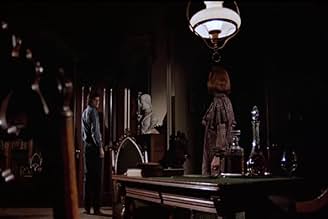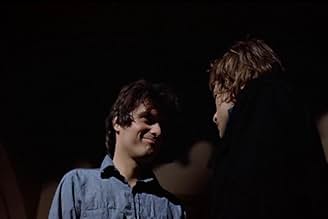NOTE IMDb
5,4/10
1,9 k
MA NOTE
Ajouter une intrigue dans votre langueA painter and his wife move into a home and find themselves plagued by ghosts and spirits of his ancestors that used to be witches.A painter and his wife move into a home and find themselves plagued by ghosts and spirits of his ancestors that used to be witches.A painter and his wife move into a home and find themselves plagued by ghosts and spirits of his ancestors that used to be witches.
Jim Storm
- Gerard Stiles
- (as James Storm)
Captain Haggerty
- Bald Henchman
- (non crédité)
Robert Singer
- Henchman
- (non crédité)
Avis à la une
For whatever reasons, perhaps largely due to reported editing room butchery, this film seems like a lump of scrapings from the bottom of the barrel of Dan Curtis's Gothic horror imagination. Several fine actors are wasted in a half-baked narrative about the efforts of young, handsome Quentin Collins (David Selby) to shake off the stubborn curse of his ancestors when he returns to the family estate in "Maine" (ha! you mean the Hudson Valley) with his fresh-faced new bride (Kate Jackson). Whereas "House of Dark Shadows" the year before incorporated plot strands from its parent TV series, this spin-off tries (and fails) to come up with a new story line involving ghosts from centuries past repeatedly taking control of Quentin's mind, making him act like one of his evil ancestors which results in spousal abuse. Nancy Barrett and John Karlen play a couple who live nearby and try to help Quentin sort things out; the lack of integration of their characters is among the most glaring signs of post-production tampering with content. Grayson Hall is the oddly fashionable and immaculate caretaker who is actually a reincarnation of a 19th century family member. Thayer David appears too briefly in a couple of hallucinatory flashbacks as a priest who supervises the hanging of the witch Lara Parker, another ghost of the past who also appears too briefly.
Much of Robert Cobert's music, particularly the underscoring in establishing shots, is annoyingly inappropriate. In the TV series his compositions enhanced virtually every scene and contributed much to the otherworldly mood. Not so much here.
Many outdoor scenes are shot in crude day-for-night fashion, sometimes under bright blue skies which cause actors' faces to disappear amid the glare. A maintenance worker in the house is cast with an actor who resembles Selby so closely that you keep mixing them up. Is this intentional? Again – editing room chicanery or dumb casting? Will we ever know? Director's cut, please.
Much of Robert Cobert's music, particularly the underscoring in establishing shots, is annoyingly inappropriate. In the TV series his compositions enhanced virtually every scene and contributed much to the otherworldly mood. Not so much here.
Many outdoor scenes are shot in crude day-for-night fashion, sometimes under bright blue skies which cause actors' faces to disappear amid the glare. A maintenance worker in the house is cast with an actor who resembles Selby so closely that you keep mixing them up. Is this intentional? Again – editing room chicanery or dumb casting? Will we ever know? Director's cut, please.
Late actress Grayson Hall was Oscar nominated for her role as Judith Fellowes in John Huston's 1964 film `Night of the Iguana'. But Hall's BEST career performance might well be found in a different 'Night of...' film. We won't know for sure unless/until the current owners of 'Night of Dark Shadows' -- the Turner/Time Warner entertainment conglomerate -- get on board for a fan-requested restoration of the film.
This story begins with the 1970 theatrical release of 'House of Dark Shadows', the first theatrical film based on a TV soap opera, 'Dark Shadows'. Giddy about the unprecedented ability of a TV soap opera to sell movie tickets, MGM executives approved a second DS film. Originally titled 'Curse of Dark Shadows', the film (directed by Dan Curtis) also starred David Selby, Lara Parker, and Kate Jackson, the three actors destined to enjoy the most post-DS mainstream success.
The 93-minute film released to theatres in 1971 as 'Night of Dark Shadows' (or NODS, in fan jargon) was roundly dismissed by critics and audiences alike. Contemporary viewers deemed the film disjointed and difficult to follow: events lacked proper motivation, characters appeared and disappeared without sufficient explanation, and there was no build-up of suspense as the film raced toward its denouement.
In a 1996 cover story he wrote for 'Video Watchdog' magazine, film historian and restorationist Darren Gross explained that a drastic, eleventh-hour editing job forced on Curtis by MGM essentially crippled the film. By all accounts, the hacking-up of NODS was more extreme and bloody than any of the make-believe violence perpetrated by the vampires, werewolves and ghosts that populated the supernatural TV series and films.
In 1999, following a long and frustrating search, Gross located an unexpurgated 129-minute cut of NODS in a studio vault housed in a Kansas City salt mine.
Gross reported that the narrative and thematic focus of the uncut NODS is completely different than that of the 93-minute release version. In 2000, Gross told readers of the 'Louisville Eccentric Observer' ('LEO') that a disturbingly Gothic mood is sustained throughout the entire runtime of the 129-minute NODS, and the emotional and sexual chemistry between the Selby and Jackson characters is brilliantly conveyed in scenes that are completely absent from the shorter version.
Some major hurdles remain to the planned restoration and DVD release of NODS, not the least of which is convincing the film's owners that the never-before-seen 129-minute version has significant commercial viability.
The following facts should help settle that argument: 1) The 1966-71 ABC series 'Dark Shadows' now boasts several generations of fans across the globe, and their interest and dedication have kept the show in syndicated reruns since shortly after its network cancellation; prior to the advent of a cable channel programmed almost exclusively with soap reruns, it was the only soap to receive such treatment; 2) NODS features Oscar nominee Grayson Hall, which lends the film importance from the perspective of cinema history; and, 3) the release version of NODS made no real sense, while the restored version does.
I invite and encourage all would-be fans of the uncut NODS to join me in voicing support for this worthwhile restoration and release project.
This story begins with the 1970 theatrical release of 'House of Dark Shadows', the first theatrical film based on a TV soap opera, 'Dark Shadows'. Giddy about the unprecedented ability of a TV soap opera to sell movie tickets, MGM executives approved a second DS film. Originally titled 'Curse of Dark Shadows', the film (directed by Dan Curtis) also starred David Selby, Lara Parker, and Kate Jackson, the three actors destined to enjoy the most post-DS mainstream success.
The 93-minute film released to theatres in 1971 as 'Night of Dark Shadows' (or NODS, in fan jargon) was roundly dismissed by critics and audiences alike. Contemporary viewers deemed the film disjointed and difficult to follow: events lacked proper motivation, characters appeared and disappeared without sufficient explanation, and there was no build-up of suspense as the film raced toward its denouement.
In a 1996 cover story he wrote for 'Video Watchdog' magazine, film historian and restorationist Darren Gross explained that a drastic, eleventh-hour editing job forced on Curtis by MGM essentially crippled the film. By all accounts, the hacking-up of NODS was more extreme and bloody than any of the make-believe violence perpetrated by the vampires, werewolves and ghosts that populated the supernatural TV series and films.
In 1999, following a long and frustrating search, Gross located an unexpurgated 129-minute cut of NODS in a studio vault housed in a Kansas City salt mine.
Gross reported that the narrative and thematic focus of the uncut NODS is completely different than that of the 93-minute release version. In 2000, Gross told readers of the 'Louisville Eccentric Observer' ('LEO') that a disturbingly Gothic mood is sustained throughout the entire runtime of the 129-minute NODS, and the emotional and sexual chemistry between the Selby and Jackson characters is brilliantly conveyed in scenes that are completely absent from the shorter version.
Some major hurdles remain to the planned restoration and DVD release of NODS, not the least of which is convincing the film's owners that the never-before-seen 129-minute version has significant commercial viability.
The following facts should help settle that argument: 1) The 1966-71 ABC series 'Dark Shadows' now boasts several generations of fans across the globe, and their interest and dedication have kept the show in syndicated reruns since shortly after its network cancellation; prior to the advent of a cable channel programmed almost exclusively with soap reruns, it was the only soap to receive such treatment; 2) NODS features Oscar nominee Grayson Hall, which lends the film importance from the perspective of cinema history; and, 3) the release version of NODS made no real sense, while the restored version does.
I invite and encourage all would-be fans of the uncut NODS to join me in voicing support for this worthwhile restoration and release project.
If ever a film needed restoration, this is it. Creepy atmospheric follow-up to House of Dark Shadows lacks the coherent plot of the first picture. Apparently the studio forced director Dan Curtis to cut his 2 hour movie down to 90 minutes so it could be sold as a double feature with House of Dark Shadows or other horror flicks--and it shows. It often doesn't make any sense and you wind up frustrated, as if you just had a good dream but can't remember it all. Word is that a complete uncut print has been recently discovered. A new DVD release of this picture restoring the missing pieces would be a big seller among Dark Shadows fans and horror film aficionados alike.
Well, almost... David Selby plays Quentin Collins, a talented young artist who moves his wife and himself into the woodsy estate once owned by his ancestors, who were involved in witchcraft and may still be hanging around; Grayson Hall is the caretaker of the manor, who knows all its dark secrets (she tells the handyman, "Everything's different now!"). Dan Curtis' continuation of themes he began with the television serial "Dark Shadows" has its effective moments, despite MGM forcing cuts to shorten the original running-time (the film is a second-cousin to the TV show out of necessity, not by design, after Jonathan Frid refused to return as Barnabas Collins, forcing Curtis in a new direction). Robert Cobert contributes a spooky score, although there is so much one-finger tapping on a piano that one gets the feeling everyone is walking around with their own keyboard. Cinematographer Robert Shore does excellent work on a tight budget, and nobody stages a creepy nightmare like Curtis (this one has a shuddery funeral in the rain, capped with a lonesome church bell and a woman laughing hysterically). The reincarnation plot isn't much, and Selby is too colorless an actor to be much of presence (or a threat), but the dark, damp location--with spirits around every corner--provides the perfect place for things that go bump in the night. ** from ****
In 1975 I was a freelance writer in New York. During that year I was honored to interview stage and screen actress and one of the stars from Dark Shadows, Grayson Hall. It was during this interview that I learned why NIGHT OF DARK SHADOWS was such a bad film.
The late Ms. Hall related a story which told of how MGM called her husband, "Dark Shadows writer" Sam Hall and told him that he would have to fly out to California and edit out nearly 30 min. from his latest film. After his sad task was done he returned home and shortly thereafter the film was released. It was not up to the standards the the series nor MGM's hit from just the year before "House of Dark Shadows" had. The idea was excellent. Dialog well written, stylishly photographed and wonderful performances from the cast. The problem was the fact that the feature made little sense. It plotted along for 90 min's filled with questions and vagueness.
However, the good news is that most of the edited footage has been found and is now in the process of being re-edited. Night of Dark Shadows, through the popularity of the series, is in a sense going to be re-born. Sam Hall's work shall now be seen as it was created. Perhaps then we will be able to appreciate this classic haunted house story, the way it should be, without studio butchering.
The late Ms. Hall related a story which told of how MGM called her husband, "Dark Shadows writer" Sam Hall and told him that he would have to fly out to California and edit out nearly 30 min. from his latest film. After his sad task was done he returned home and shortly thereafter the film was released. It was not up to the standards the the series nor MGM's hit from just the year before "House of Dark Shadows" had. The idea was excellent. Dialog well written, stylishly photographed and wonderful performances from the cast. The problem was the fact that the feature made little sense. It plotted along for 90 min's filled with questions and vagueness.
However, the good news is that most of the edited footage has been found and is now in the process of being re-edited. Night of Dark Shadows, through the popularity of the series, is in a sense going to be re-born. Sam Hall's work shall now be seen as it was created. Perhaps then we will be able to appreciate this classic haunted house story, the way it should be, without studio butchering.
Le saviez-vous
- AnecdotesFeature film debut of Kate Jackson.
- GaffesNear the beginning, Quentin goes to bed wearing gold (or yellow) pajamas. Then in his nightmare sequences that follow the pajamas are blue.
- Citations
Carlotta Drake: There is no longer any place for Mrs. Collins.
- Versions alternativesThe original director's cut of Night of Dark Shadows was screened for MGM executives at 128 minutes. Unhappy with the running time, studio head James Aubrey ordered director Dan Curtis to cut around 40 minutes out of the picture, as it was considered a B-programmer. Curtis was given only 24 hours to re-cut the picture, and the 97 minute version was approved by Aubrey. The picture was press screened at that length, but afterward an additional 4 minutes were cut from the picture without Dan Curtis' consent, probably in order to guarantee a GP rating (1971's PG equivalent) as all of this material cut was violent or sexually suggestive in nature. During release some of the preview (97 mins) prints were accidentally circulated and still show up today, probably through private collectors as the 97 min prints are no longer held in MGM's archive. Dan Curtis' 128 min original version has been considered lost and presumed destroyed for decades, but film historian Darren Gross unearthed the sole existing material for this version in August 1999. Plans for restoration and release of this version are currently being formulated.
- ConnexionsFeatured in Cinemacabre TV Trailers (1993)
Meilleurs choix
Connectez-vous pour évaluer et suivre la liste de favoris afin de recevoir des recommandations personnalisées
- How long is Night of Dark Shadows?Alimenté par Alexa
Détails
Box-office
- Budget
- 900 000 $US (estimé)
- Durée
- 1h 35min(95 min)
- Mixage
- Rapport de forme
- 1.85 : 1
Contribuer à cette page
Suggérer une modification ou ajouter du contenu manquant


